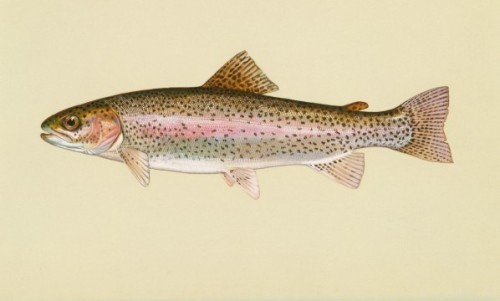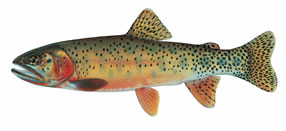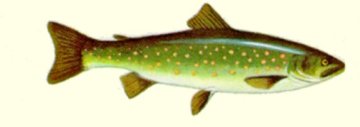This is a re-post from guest author Skook:
Glaciers and mountain-building have created many distinct species of trout throughout the Pacific drainage. To find them, fish a mountain river, take a boat out on the Pacific, or hike to a desert lake.

Rainbow (above) – Silver with black spots and a reddish band along the side. Their native range is the West Coast mountains, though they have been introduced elsewhere in North America and beyond. Redbands are a variant found in the Great Basin, where they have adapted to high summer temperatures. Steelheads are anadromous rainbows that spend parts of their lives in the North Pacific from Kamchatka down to Malibu Creek near Los Angeles. In the Northwest, rainbows and steelhead are the premier game trout of the rivers and coast.
(While Rainbows are to be found in the East, these are all transplants or hatchery fish. The native stream trout in the East is the Brook Trout - which is a char.)
 Cutthroat – Meriwether Lewis stopped at a Philadelphia tackle shop before setting out and his purchases served his expedition well, like on the Great Falls of the Missouri in June 1805. Private Silas Goodrich fished the river as Lewis described events. Goodrich caught a trout “with specks of a deep black…and a small dash of red on each side behind the front ventral fins… the flesh, when in good order, of a rose red.” There are at least 14 types, often unique to particular river systems. Cutthroats are the classic trout of the inland American West, and they sometimes interbreed with Rainbows.
Cutthroat – Meriwether Lewis stopped at a Philadelphia tackle shop before setting out and his purchases served his expedition well, like on the Great Falls of the Missouri in June 1805. Private Silas Goodrich fished the river as Lewis described events. Goodrich caught a trout “with specks of a deep black…and a small dash of red on each side behind the front ventral fins… the flesh, when in good order, of a rose red.” There are at least 14 types, often unique to particular river systems. Cutthroats are the classic trout of the inland American West, and they sometimes interbreed with Rainbows.
 Dolly Varden - These are char (as is the eastern Brook Trout), like trout but with different teeth and coloration. Dollys are olive or gray-green with yellow to pink spots and light gray bellies. A character from a Dickens novel, Dolly Varden became the name of a patterned dress and in the 1870’s the name was given to the char found in California’s McCloud River. Dolly Varden are similar to Bull Trout, another char, and at one time they were thought to be the same species. They spend time in the ocean as do Cutthroats.
Dolly Varden - These are char (as is the eastern Brook Trout), like trout but with different teeth and coloration. Dollys are olive or gray-green with yellow to pink spots and light gray bellies. A character from a Dickens novel, Dolly Varden became the name of a patterned dress and in the 1870’s the name was given to the char found in California’s McCloud River. Dolly Varden are similar to Bull Trout, another char, and at one time they were thought to be the same species. They spend time in the ocean as do Cutthroats.
There are a few other species found in isolated areas that exist today only due to the hard work of folks like Trout Unlimited. Here are two examples:
Apache Trout - Jump in your car and drive to the Ft. Apache Indian Reservation about three hours northeast of Phoenix. There in the White River is the gold, red, and black Apache. It has been a long struggle due to loss of habitat and interbreeding with rainbows. But now things look good enough to move it from the endangered list to merely “threatened” so you may legally try your luck at catch and release.
Gila Trout – Another modestly reviving species in eastern Arizona and western New Mexico, it too had been pushed to the brink by development and competition with non-native trout introduced decades ago. Gilas have black spots on gold and copper bodies and grow to over a foot. Long term restoration has brought them back enough to permit limited fishing in a few beautiful mountain streams. Bring your hiking boots.



 Cutthroat – Meriwether Lewis stopped at a Philadelphia tackle shop before setting out and his purchases served his expedition well, like on the Great Falls of the Missouri in June 1805. Private Silas Goodrich fished the river as Lewis described events. Goodrich caught a trout “with specks of a deep black…and a small dash of red on each side behind the front ventral fins… the flesh, when in good order, of a rose red.” There are at least 14 types, often unique to particular river systems.
Cutthroat – Meriwether Lewis stopped at a Philadelphia tackle shop before setting out and his purchases served his expedition well, like on the Great Falls of the Missouri in June 1805. Private Silas Goodrich fished the river as Lewis described events. Goodrich caught a trout “with specks of a deep black…and a small dash of red on each side behind the front ventral fins… the flesh, when in good order, of a rose red.” There are at least 14 types, often unique to particular river systems.  Dolly Varden - These are char (as is the eastern Brook Trout), like trout but with different teeth and coloration. Dollys are olive or gray-green with yellow to pink spots and light gray bellies. A character from a Dickens novel, Dolly Varden became the name of a patterned dress and in the 1870’s the name was given to the char found in California’s McCloud River.
Dolly Varden - These are char (as is the eastern Brook Trout), like trout but with different teeth and coloration. Dollys are olive or gray-green with yellow to pink spots and light gray bellies. A character from a Dickens novel, Dolly Varden became the name of a patterned dress and in the 1870’s the name was given to the char found in California’s McCloud River.
That's your hard-working Editor in the background, fishing in April a couple of years ago. It's time to review some of our good trout posts from the past.For new readers, here's our first post on Fishing Bamboo.And here's a post about Hoagy Carmichael Jr.
Tracked: Mar 28, 19:01